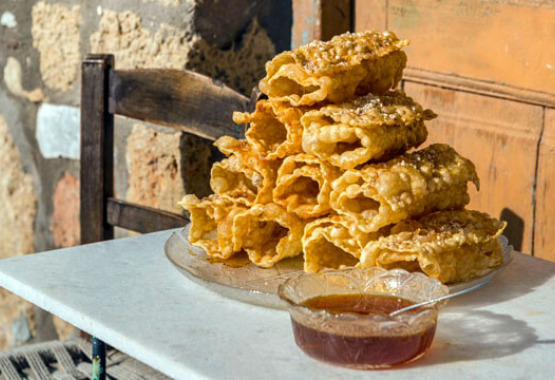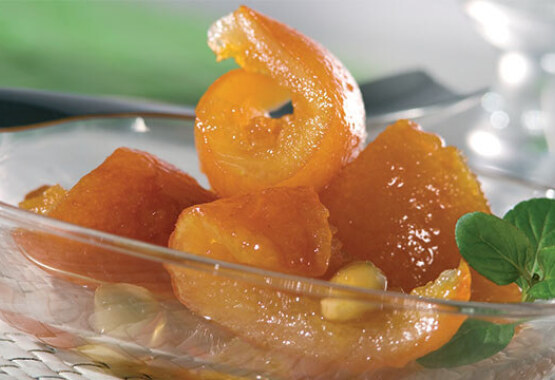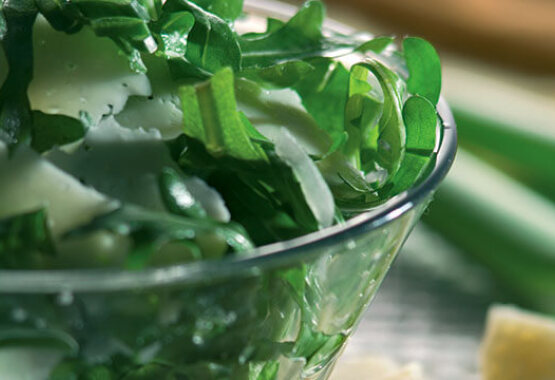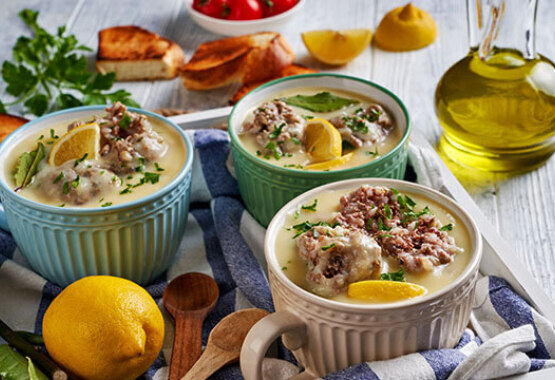
AROUND GREECE
Across Greece you will find a large variety of wholesome and flavourful meat-free dishes that will offer new thrills to your palate. It’s a great opportunity to detox your body from animal-related products, too. Here’s a selection of great-tasting Greek veggie dishes that will put to the test even the steadiest meat-eaters among you.
Choriatiki is a very popular Greek salad which is made with freshly cut thick wedges of tomatoes, cucumber and onion slices, feta cheese, delicious olives, virgin olive oil and flavourful crushed dried oregano leaves; it’s the perfect starter that will whet your appetite for the main course. Dakos salad is a Cretan salad, which contains a piece of round water-dampened barley rusk topped with chopped fresh tomatoes, crumbled feta or myzithra cheese, olive slices, capers and sprinkled with dried oregano (Useful tip: Allow the juices to soak the rusk for a few minutes, then taste). Savour mouthwatering boiled greens served with olive oil and lemon juice or vinegar to suit your taste.
Try the following tempting mezedes (appetisers or side dishes): fried or grilled vegetables or cheese such as fried tomato balls, green vegetable patties, and saganaki cheese (fried feta or hard yellow cheese). Sliced courgettes can be boiled or fried. They are also used to make delicious patties (mixed with herbs and/or cheese). The sweet-tasting fried slices of aubergine and the rice & herb - stuffed courgette blossoms are two must-try dishes, mostly served in the summer and autumn.
Accompany your vegetarian appetisers with some great-tasting dips:
Taramosalata: a mousse salad made from fish roe blended with lemon, bread, olive oil.
Melitzanosalata: A puree of grilled or smoked aubergines with olive oil, garlic and vinegar.
Tzatziki: It’s the most famous Greek appetiser, made with creamy Greek yoghurt, grated cucumber & garlic, and finely chopped dill, blended with oil, vinegar and salt.
Skordalia: it’s a vegan dip made with mashed potatoes or bread, garlic, olive oil, vinegar, salt & pepper. It usually accompanies fried cod, and boiled beets (patzaria in Greek).
Pulses have been an essential part of the Greek diet since antiquity. Yellow split peas, gigantes (large dried white runner beans), broad beans, lentils, black-eyed peas and chickpeas all hold an important place in the Greek cuisine and are an essential part of the Mediterranean Diet. Today, healthy eating habits include legume dishes in the weekly food planning, as they contain a high percentage of protein, iron, and fibre; little to no fat; no cholesterol; and significant amounts of minerals, such as potassium, zinc, magnesium and calcium.
Pulses are cooked in hot nourishing soups in the winter; they are also great in salads mixed with herbs and vegetables in the summer. Northern Greece yields top quality pulses, as the soil is rich in potassium, an element that makes them more flavourful and contributes to shorter boiling times. Beans from Lake Prespes area; lentils from Voio, Kozani; yellow split peas from Feneos, Korinthia and from Santorini Island; lentils from Eglouvi, Lefkada Island; chickpeas from Larisa or Grevena; they are all well-known top quality produce on account of each area’s favourable microclimate.
Ladera (meaning cooked with olive oil)
Olive oil has always been a product precious to Greeks, one that has been considered sacred since the ancient times. Its importance has been evident in millennia-old traditions about everyday life, religious and cultural practices.
Ladera dishes are colourful and most flavourful. Vegetables are cooked either fresh or dried in the pot in low to medium temperatures, so as to best retain their shape and flavour. Here are some tasty Greek vegetarian dishes for you to try: peas and okras (stewed with tomatoes); artichokes (cooked with potatoes, carrots, lots of finely chopped dill, and lemon juice –the ‘a la polita’ dish); courgettes, potatoes, carrots, bell peppers, aubergines, onions baked with tomato sauce and spices (a dish called ‘briam’); aubergines cooked with tomatoes, onions, garlic, parsley, dill and spices (a dish called ‘imam’); and oven-baked stuffed tomatoes, peppers, courgettes, aubergines filled with a mixture made with rice, the flesh of the above vegetables, herbs & spices (a heavenly dish called ‘gemista’).
Extra tip: If you eat dairy, enjoy them with a slice of feta cheese.
Pies, the veggie way
Pies are very popular among Greeks and they come in all sorts of variations: savoury, sweet, dressed with phyllo sheet or flaky pastry (called ‘sfoliata’), round, triangular or coil-shaped, with few ingredients, or more elaborate ones. Age-old household management rules point towards the optimum use of seasonal produce, resulting in a large variety of tasty creations. Pies can be served as a main dish, as a side dish or as a healthy and tasty snack during the day.
Pie filling variations depend only on the maker’s imagination and the local bounty of nature. Practically everything can be included in a pie: cheese, greens, pasta, rice, trachanas, vegetables and so on. Greek ingenuity has led to a large number of pie creations: cheese pie, spinach pie, leek pie, nettle pie, mushroom pie, onion pie, cabbage pie, potato pie, pasta pie, pumpkin pie, and so on...
Greek Pasta
You can find Greek pasta in many a shape and size; some types contain milk and eggs, or they can be a simple -yet very tasty- mixture of durum wheat or semolina, water and salt. The pasta-making tradition is kept alive mostly by women living in the countryside (who usually prepare the pasta and allow it to dry out in the sun during the summer). They also participate in regional cooperatives producing and selling a large variety of artisan pasta. Such regional co-ops exist all over Greece, on the mainland and islands alike. In these co-ops you will find popular Greek pasta such as chylopites (noodles that come in two basic shapes: small squares or thin, fettuccine-like strips), kritharaki (orzo), trachanas (a granular pasta made with semolina or wheat flour or cracked wheat, kneaded with milk or yoghurt or buttermilk), lazania (broad strips of egg pasta), fides (angel’s hair), and astraki (a small star-shaped pasta).
Veggie suggestions while in Greece
Some of you may think that Greek cuisine is all about meat and the truth is that Greeks do know their way around a grill. But it’s also true that traditional Greek cooking offers vegetarians a large variety of tasty dishes to choose from, where flavour is combined with high nutritional value. The Greek cuisine has four secrets; high quality fresh ingredients, wise use of herbs and spices, the famous Greek olive oil and a hearty dose of loving care! It is based on fresh seasonal vegetables and fruit, grains, legumes, and greens – the perfect combination for vegetarians and vegans.Across Greece you will find a large variety of wholesome and flavourful meat-free dishes that will offer new thrills to your palate. It’s a great opportunity to detox your body from animal-related products, too. Here’s a selection of great-tasting Greek veggie dishes that will put to the test even the steadiest meat-eaters among you.
Appetisers, salads and dips
Choriatiki is a very popular Greek salad which is made with freshly cut thick wedges of tomatoes, cucumber and onion slices, feta cheese, delicious olives, virgin olive oil and flavourful crushed dried oregano leaves; it’s the perfect starter that will whet your appetite for the main course. Dakos salad is a Cretan salad, which contains a piece of round water-dampened barley rusk topped with chopped fresh tomatoes, crumbled feta or myzithra cheese, olive slices, capers and sprinkled with dried oregano (Useful tip: Allow the juices to soak the rusk for a few minutes, then taste). Savour mouthwatering boiled greens served with olive oil and lemon juice or vinegar to suit your taste.Try the following tempting mezedes (appetisers or side dishes): fried or grilled vegetables or cheese such as fried tomato balls, green vegetable patties, and saganaki cheese (fried feta or hard yellow cheese). Sliced courgettes can be boiled or fried. They are also used to make delicious patties (mixed with herbs and/or cheese). The sweet-tasting fried slices of aubergine and the rice & herb - stuffed courgette blossoms are two must-try dishes, mostly served in the summer and autumn.
Accompany your vegetarian appetisers with some great-tasting dips:
Taramosalata: a mousse salad made from fish roe blended with lemon, bread, olive oil.
Melitzanosalata: A puree of grilled or smoked aubergines with olive oil, garlic and vinegar.
Tzatziki: It’s the most famous Greek appetiser, made with creamy Greek yoghurt, grated cucumber & garlic, and finely chopped dill, blended with oil, vinegar and salt.
Skordalia: it’s a vegan dip made with mashed potatoes or bread, garlic, olive oil, vinegar, salt & pepper. It usually accompanies fried cod, and boiled beets (patzaria in Greek).
Main course
Legumes & pulsesPulses have been an essential part of the Greek diet since antiquity. Yellow split peas, gigantes (large dried white runner beans), broad beans, lentils, black-eyed peas and chickpeas all hold an important place in the Greek cuisine and are an essential part of the Mediterranean Diet. Today, healthy eating habits include legume dishes in the weekly food planning, as they contain a high percentage of protein, iron, and fibre; little to no fat; no cholesterol; and significant amounts of minerals, such as potassium, zinc, magnesium and calcium.
Pulses are cooked in hot nourishing soups in the winter; they are also great in salads mixed with herbs and vegetables in the summer. Northern Greece yields top quality pulses, as the soil is rich in potassium, an element that makes them more flavourful and contributes to shorter boiling times. Beans from Lake Prespes area; lentils from Voio, Kozani; yellow split peas from Feneos, Korinthia and from Santorini Island; lentils from Eglouvi, Lefkada Island; chickpeas from Larisa or Grevena; they are all well-known top quality produce on account of each area’s favourable microclimate.
Ladera (meaning cooked with olive oil)
Olive oil has always been a product precious to Greeks, one that has been considered sacred since the ancient times. Its importance has been evident in millennia-old traditions about everyday life, religious and cultural practices.
Ladera dishes are colourful and most flavourful. Vegetables are cooked either fresh or dried in the pot in low to medium temperatures, so as to best retain their shape and flavour. Here are some tasty Greek vegetarian dishes for you to try: peas and okras (stewed with tomatoes); artichokes (cooked with potatoes, carrots, lots of finely chopped dill, and lemon juice –the ‘a la polita’ dish); courgettes, potatoes, carrots, bell peppers, aubergines, onions baked with tomato sauce and spices (a dish called ‘briam’); aubergines cooked with tomatoes, onions, garlic, parsley, dill and spices (a dish called ‘imam’); and oven-baked stuffed tomatoes, peppers, courgettes, aubergines filled with a mixture made with rice, the flesh of the above vegetables, herbs & spices (a heavenly dish called ‘gemista’).
Extra tip: If you eat dairy, enjoy them with a slice of feta cheese.
Pies, the veggie way
Pies are very popular among Greeks and they come in all sorts of variations: savoury, sweet, dressed with phyllo sheet or flaky pastry (called ‘sfoliata’), round, triangular or coil-shaped, with few ingredients, or more elaborate ones. Age-old household management rules point towards the optimum use of seasonal produce, resulting in a large variety of tasty creations. Pies can be served as a main dish, as a side dish or as a healthy and tasty snack during the day.
Pie filling variations depend only on the maker’s imagination and the local bounty of nature. Practically everything can be included in a pie: cheese, greens, pasta, rice, trachanas, vegetables and so on. Greek ingenuity has led to a large number of pie creations: cheese pie, spinach pie, leek pie, nettle pie, mushroom pie, onion pie, cabbage pie, potato pie, pasta pie, pumpkin pie, and so on...
Greek Pasta
You can find Greek pasta in many a shape and size; some types contain milk and eggs, or they can be a simple -yet very tasty- mixture of durum wheat or semolina, water and salt. The pasta-making tradition is kept alive mostly by women living in the countryside (who usually prepare the pasta and allow it to dry out in the sun during the summer). They also participate in regional cooperatives producing and selling a large variety of artisan pasta. Such regional co-ops exist all over Greece, on the mainland and islands alike. In these co-ops you will find popular Greek pasta such as chylopites (noodles that come in two basic shapes: small squares or thin, fettuccine-like strips), kritharaki (orzo), trachanas (a granular pasta made with semolina or wheat flour or cracked wheat, kneaded with milk or yoghurt or buttermilk), lazania (broad strips of egg pasta), fides (angel’s hair), and astraki (a small star-shaped pasta).




